179: Difference between revisions
Pbcjohnston (talk | contribs) (→Pre-war: Added caption) |
Pbcjohnston (talk | contribs) (→Marine Railway Incident, 1942: Added captions) |
||
| Line 16: | Line 16: | ||
[[File:Plunger railway 1.jpg|left|500px]] | [[File:Plunger railway 1.jpg|left|500px]] | ||
<div style="text-align: justify;"><span style="color:#00008B"> | <div style="text-align: justify;"><span style="color:#00008B">On February 17, 1942, Plunger was being hauled out of the water for routine hull maintenance at the marine railways at the Pearl Harbor Navy Yard. By 1527 she had motored in to the railways and was on the keel blocks, by 1530 she had secured her engines. At 1545, while being pulled from the water, the starboard keel blocks gave way, allowing the submarine to roll until she came to rest at an angle of 60 degrees against the steel framework of the railways side. One sailor broke his left arm and two others were bruised. Plunger herself received only minor damage. All photos are dated February 17, 1942; the day of the accident, roughly 90 minutes to two hours after Plunger rolled. | ||
To the left in the photo is the Clemson-class destroyer USS Greene (DD-266). In the far background is the floating derrick YD-25, a fixture at the Pearl Harbor Navy Yard since 1915. | |||
<small>NARA San Francisco photos via Tracy White and Navsource.org.</small> | |||
[[File:Red bar sub new.jpg]] | |||
[[File:Plunger railway 2.jpg|left|500px]] | [[File:Plunger railway 2.jpg|left|500px]] | ||
A view from the stern of Plunger, rolled to starboard and leaning precariously against the side of the marine railway. At least one of her aft torpedo tube shutter doors are open. The frame-like structures on either side of the stern are propeller guards. | |||
<small>NARA San Francisco photos via Tracy White and Navsource.org.</small> | |||
[[File:Red bar sub new.jpg]] | |||
[[File:Plunger railway 3.jpg|left|500px]] | [[File:Plunger railway 3.jpg|left|500px]] | ||
A view of Plunger's keel area as she was rolled to starboard on the marine railway. The oval openings near the keel and below the bilge keel are the Kingston valves that close off the bottom of the ballast tanks. In a later overhaul these Kingstons would be removed as unnecessary and the boat would "ride the vents" while surfaced, keeping air in the ballast tanks solely by the vents at the top of each tank. Fleet submarines after the early Gato-class boats would never have the Kingston's installed during construction. Most of the remainder had them removed. Just below the Kingstons are white blocks of zinc attached to the hull. These zinc plates help to reduce galvanic corrosion. They have to be replaced at regular intervals. | |||
<small>NARA San Francisco photos via Tracy White and Navsource.org.</small> | |||
[[File:Red bar sub new.jpg]] | |||
[[File:Plunger railway 4.jpg|left|500px]] | [[File:Plunger railway 4.jpg|left|500px]] | ||
A view of Plunger's stern showing the propeller shafts, support struts, and the rudder. | |||
<small>NARA San Francisco photos via Tracy White and Navsource.org.</small> | |||
[[File:Red bar sub new.jpg]] | |||
[[File:Plunger railway 5.jpg|left|500px]] | [[File:Plunger railway 5.jpg|left|500px]] | ||
A view from Plunger's bow showing how shoring was put in place to temporarily stabilize the boat until she could be righted. The starboard side of the railway dock was damaged when the Plunger's conning tower fairwater struck it. | |||
<small>NARA San Francisco photos via Tracy White and Navsource.org.</small> | |||
[[File:Red bar sub new.jpg]] | |||
[[File:Plunger railway 6.jpg|left|500px]] | [[File:Plunger railway 6.jpg|left|500px]] | ||
The view from underneath the rolled over Plunger. This incident was a failure of the dockyard engineers to properly place and secure the keel blocks. It can be safely assumed that they were in a hurry given the war situation. It is remarkable that the boat was not seriously damaged and that injuries were slight. | |||
<small>NARA San Francisco photos via Tracy White and Navsource.org.</small> | |||
[[File:Red bar sub new.jpg]] | |||
[[File:Plunger railway 7.jpg|left|500px]] | |||
By April 10, 1942, Plunger was back upright and the original work was proceeding apace. Most of her decking and portions of her superstructure have been removed. Note details of her conning tower fairwater and the periscope shears, still unmodified in this photo. The two periscopes have a stepped appearance because #1 scope lets into the control room and #2 lets into the conning tower. On the port side of the shears is a circular Radio Direction Finder (RDF) loop antenna. The odd shaped object on the cigarette deck aft of the bridge covered by a tarpaulin is a water-cooled M2 .50 caliber machine gun, always mounted in port for quick use against attacking aircraft. Note the aircraft carrier in the right background. | |||
<small>NARA San Francisco photos via Tracy White and Navsource.org.</small> | |||
[[File:Red bar sub new.jpg]] | [[File:Red bar sub new.jpg]] | ||
Revision as of 21:10, 13 November 2023
Pre-war

Photo courtesy of the digital collections of the National WWII Museum.
Marine Railway Incident, 1942
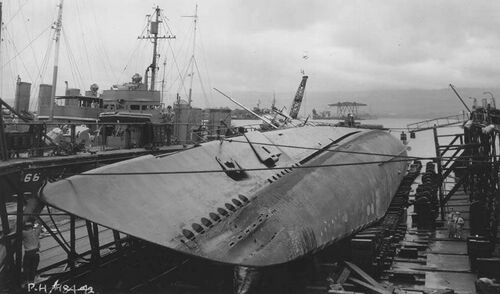
To the left in the photo is the Clemson-class destroyer USS Greene (DD-266). In the far background is the floating derrick YD-25, a fixture at the Pearl Harbor Navy Yard since 1915.
NARA San Francisco photos via Tracy White and Navsource.org.
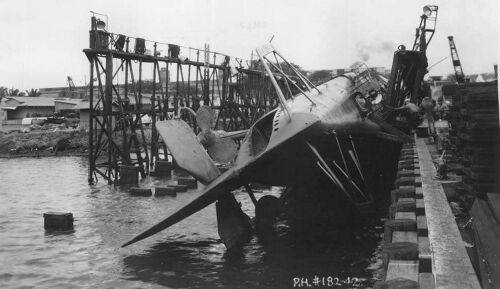
A view from the stern of Plunger, rolled to starboard and leaning precariously against the side of the marine railway. At least one of her aft torpedo tube shutter doors are open. The frame-like structures on either side of the stern are propeller guards.
NARA San Francisco photos via Tracy White and Navsource.org.

A view of Plunger's keel area as she was rolled to starboard on the marine railway. The oval openings near the keel and below the bilge keel are the Kingston valves that close off the bottom of the ballast tanks. In a later overhaul these Kingstons would be removed as unnecessary and the boat would "ride the vents" while surfaced, keeping air in the ballast tanks solely by the vents at the top of each tank. Fleet submarines after the early Gato-class boats would never have the Kingston's installed during construction. Most of the remainder had them removed. Just below the Kingstons are white blocks of zinc attached to the hull. These zinc plates help to reduce galvanic corrosion. They have to be replaced at regular intervals.
NARA San Francisco photos via Tracy White and Navsource.org.

A view of Plunger's stern showing the propeller shafts, support struts, and the rudder.
NARA San Francisco photos via Tracy White and Navsource.org.
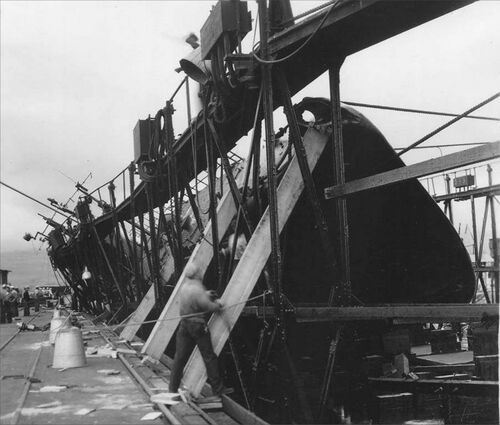
A view from Plunger's bow showing how shoring was put in place to temporarily stabilize the boat until she could be righted. The starboard side of the railway dock was damaged when the Plunger's conning tower fairwater struck it.
NARA San Francisco photos via Tracy White and Navsource.org.
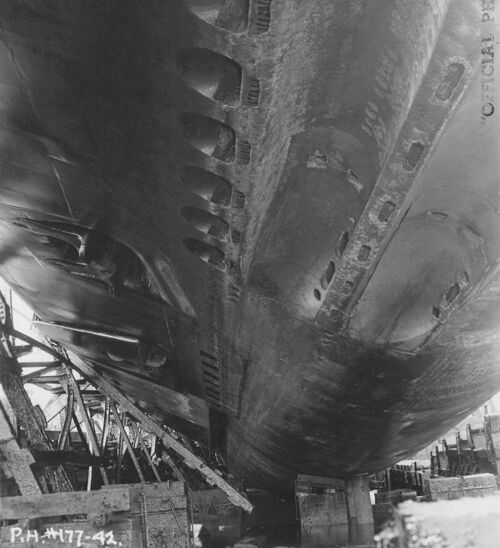
The view from underneath the rolled over Plunger. This incident was a failure of the dockyard engineers to properly place and secure the keel blocks. It can be safely assumed that they were in a hurry given the war situation. It is remarkable that the boat was not seriously damaged and that injuries were slight.
NARA San Francisco photos via Tracy White and Navsource.org.
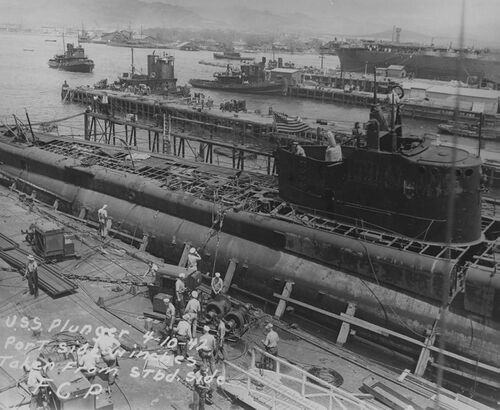
By April 10, 1942, Plunger was back upright and the original work was proceeding apace. Most of her decking and portions of her superstructure have been removed. Note details of her conning tower fairwater and the periscope shears, still unmodified in this photo. The two periscopes have a stepped appearance because #1 scope lets into the control room and #2 lets into the conning tower. On the port side of the shears is a circular Radio Direction Finder (RDF) loop antenna. The odd shaped object on the cigarette deck aft of the bridge covered by a tarpaulin is a water-cooled M2 .50 caliber machine gun, always mounted in port for quick use against attacking aircraft. Note the aircraft carrier in the right background.
NARA San Francisco photos via Tracy White and Navsource.org.
At Midway Atoll, July 1942




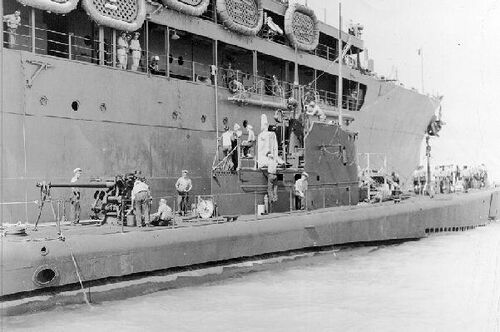
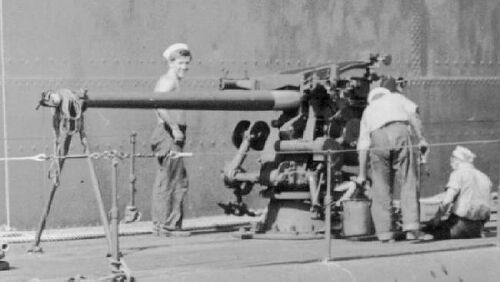
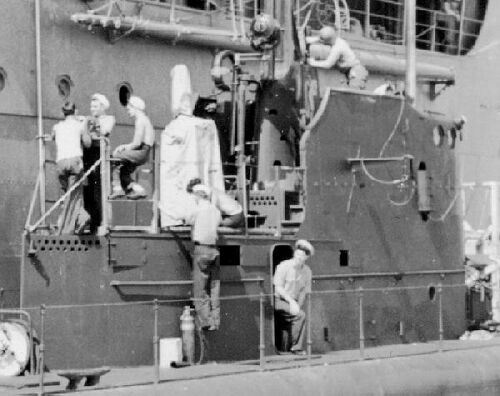
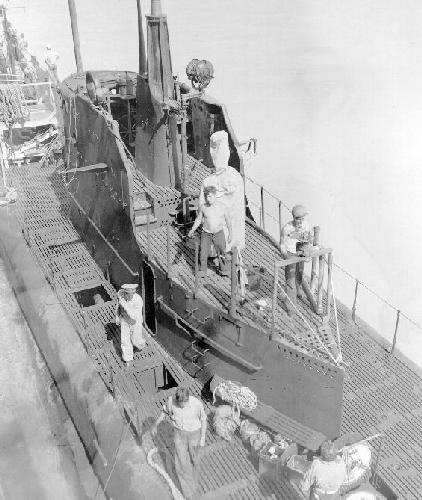
Crew Photos, 1943
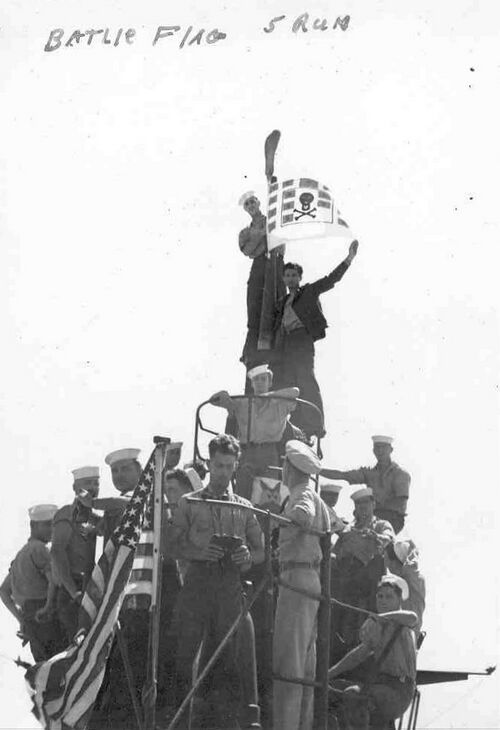
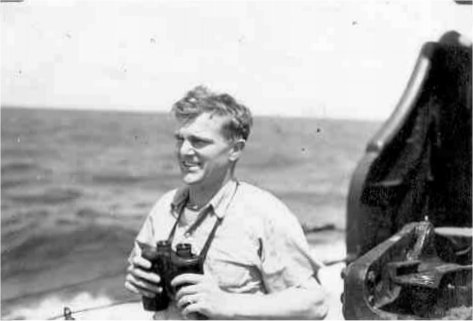


Post War
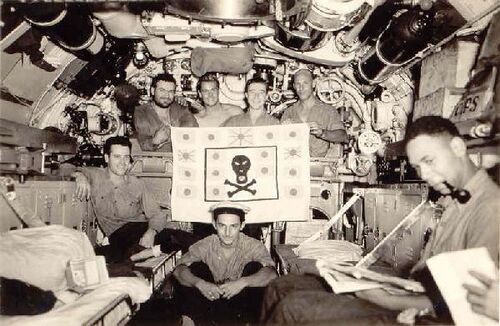

Page created by:
Ric Hedman & David Johnston
1999 - 2023 - PigBoats.COM©
Mountlake Terrace, WA, Norfolk, VA
webmaster at pigboats dot com
